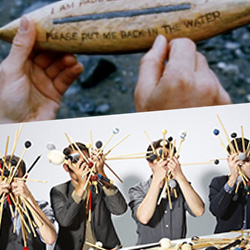by Nicholas Stevens

Third Coast’s concert on Sunday afternoon, February 11 represented a sort of homecoming for the piece, which the Museum helped commission. It was Thomas Welsh, CMA’s Director of Performing Arts, who first suggested that the quartet look at the 1941 children’s book Paddle-to-the-Sea by Holling C. Holling and Bill Mason’s 1966 short film based on the book. For their multimedia event, Third Coast alternates performances of pieces by Philip Glass, Jacob Druckman, and the mbira masters of the Shona people with portions of the film, screened along with the quartet’s original music.
The presentation opens with renditions of Glass’s “Madeira,” a movement from the suite Águas da Amazônia (1993-99), and Druckman’s “Crystalline,” from Reflections on the Nature of Water (1986). Glass’s music emerges transfigured from an overhaul by the Brazilian ensemble Uakti in the late 1990s, and Third Coast’s re-scored version sets a tone of warmth and gentle power. Druckman’s marimba solo offers a contrast, and Skidmore thundered away at the instrument’s low end.
Act 1 of Paddle to the Sea follows a carving of a man in a canoe as it begins its journey downriver toward the Great Lakes, when its maker — a First Nations boy in rural Canada — sets it afloat with a message on the bottom: “Please put me back in the water. I am Paddle-to-the-Sea.” The percussionists mostly avoid mimicry of the events in the silenced image track, though their propulsive thwacking adds a note of humor to the scene in which the boy carves the canoe. Making full use of contemporary percussion technique, they pull off such tricky maneuvers as bending the pitch of a vibraphone’s bars while bowing, and coaxing a continuous roar from a bass drum with a rubber ball.
After Glass’s “Amazon” and Druckman’s “Relentless,” the latter of which Connors tackled ably, the group reached the heart of the film. Act 2 is a nonstop succession of high points. Third Coast’s score illuminates this turbulent middle portion, which finds the toy barely missing a ship’s propellers, becoming stuck in ice, being snatched by a desirous child, encountering polluted water, and going over Niagara Falls. Rather than bang out some triumphal theme when Paddle-to-the-Sea passes a city during a fireworks display, Third Coast instead paints the shimmer of the explosions on water in spectral, ringing sounds.
Dillon lent extraordinary narrative shape to Druckman’s “Profound,” and the group allowed Glass’s “Xingu” to groove as a prelude to Act 3. As Paddle-to-the-Sea passes into the ocean, the percussionists revisit a thrumming theme for open water, defined by the hiss of a sizzle cymbal.
Martin navigated eddies of notes in Druckman’s “Fleet” to connect Act 3 with the film’s Coda, which brings renewal to both the carving and its journey. The show ended with a moving group performance of Chigwaya, a traditional Zimbabwean song that was taught to the group by their Shona mbira mentor Musekiwa Chingodza. Singing unamplified over the sparkle and buzz of their thumb pianos, Third Coast reminded listeners that the common humanity and concern for nature embedded in Holling’s story and Mason’s film transcends North American cultures, extending to artists and storytellers across all seas.
Published on ClevelandClassical.com February 14, 2018.
Click here for a printable copy of this article



